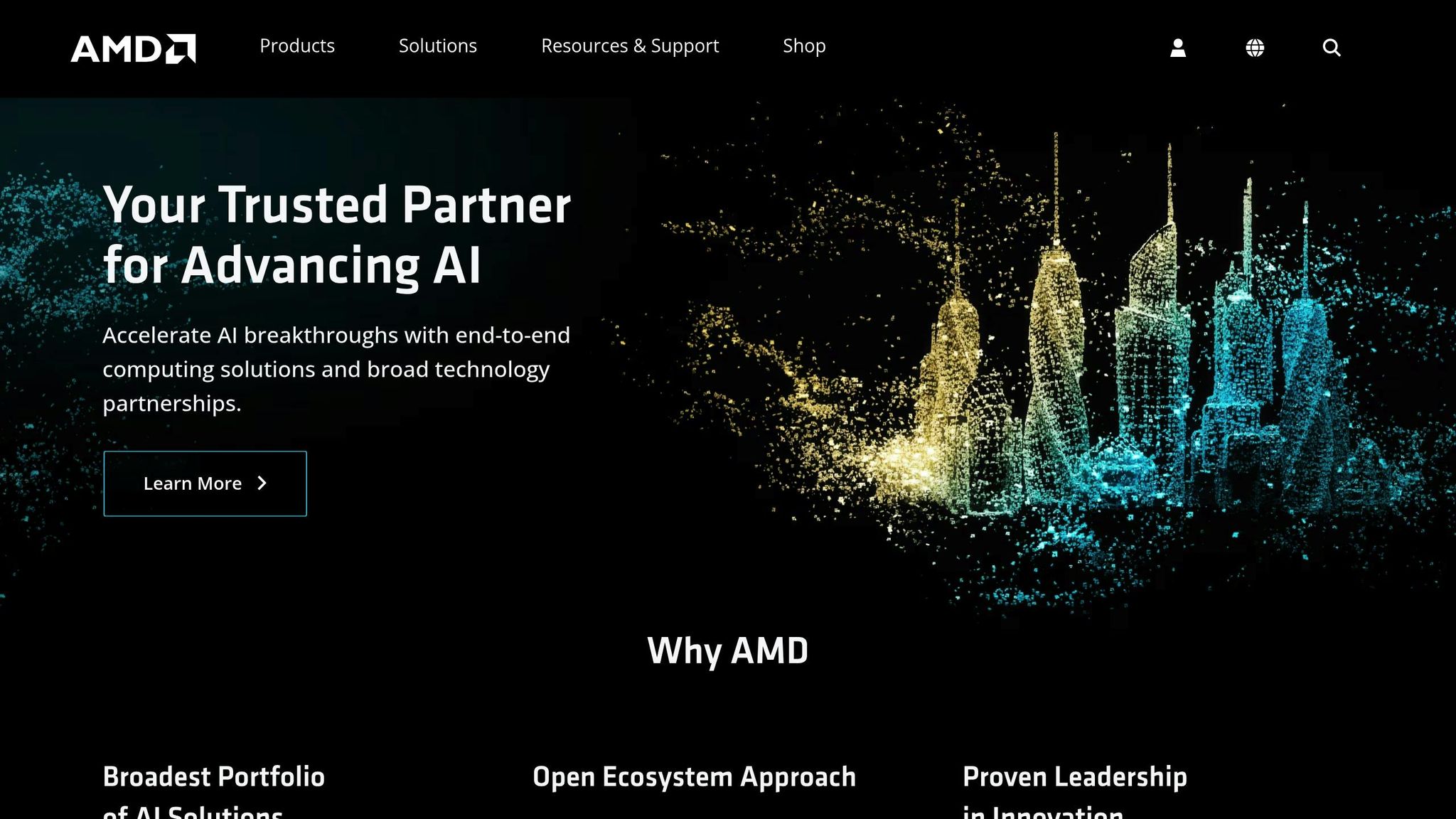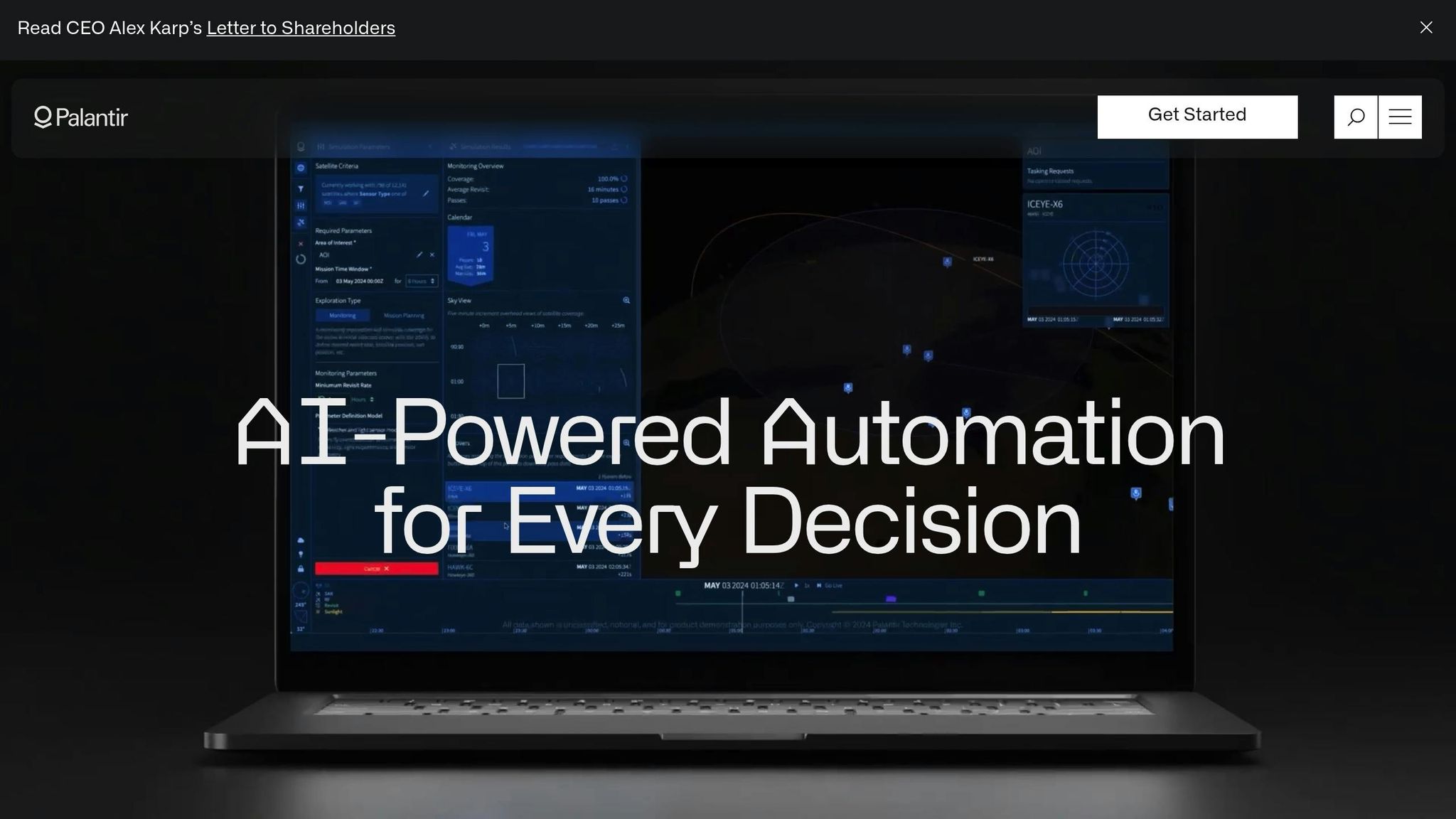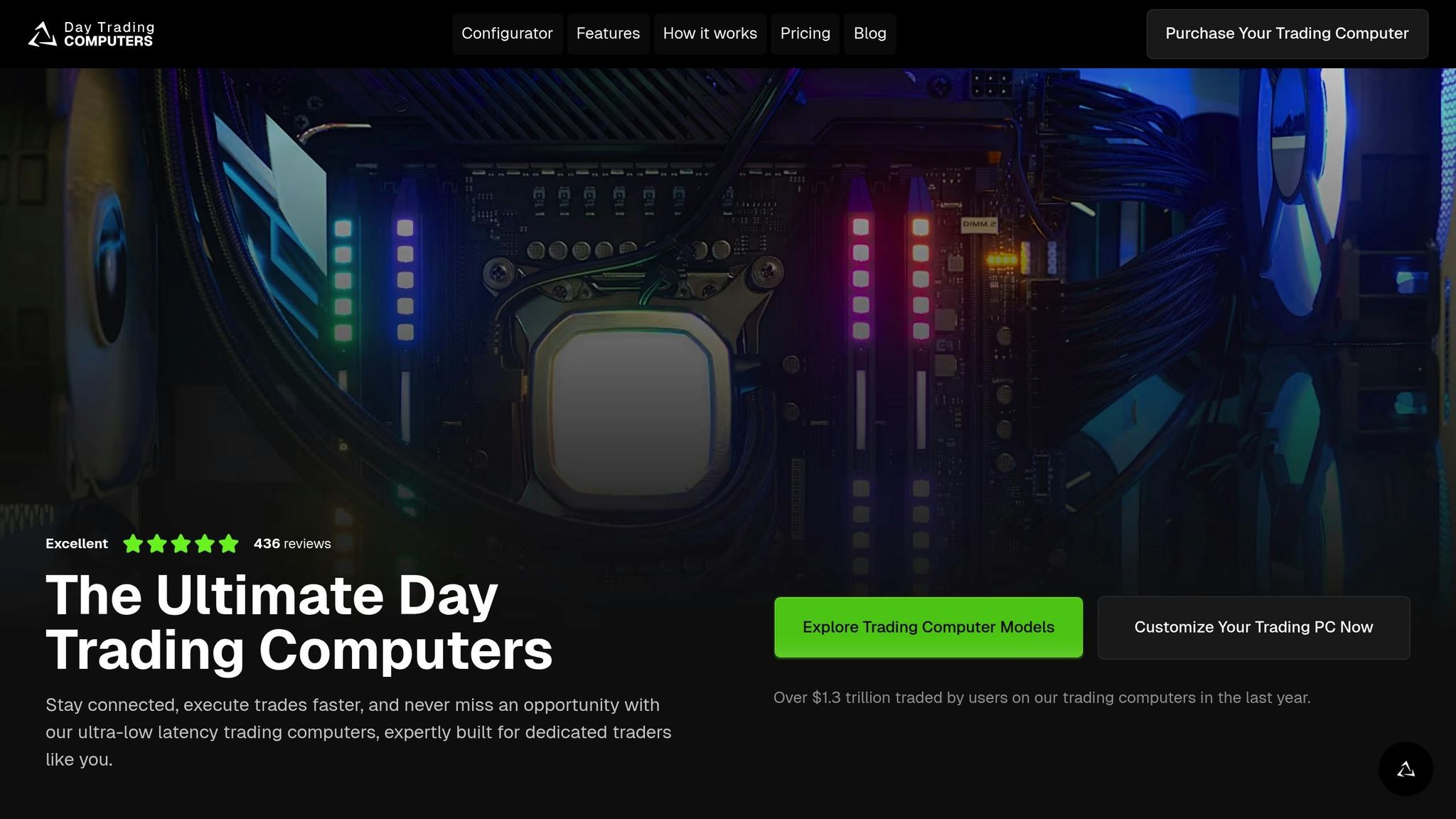Looking to trade in fast-moving markets? Here’s a quick guide to the most volatile stocks in the US and Canada for July 21, 2025. Volatility creates opportunities for day traders to profit from rapid price swings. Today’s top picks include Tesla (TSLA), NVIDIA (NVDA), and Shopify (SHOP.TO), among others. These stocks offer high daily percentage movements, strong trading volume, and liquidity – key factors for effective day trading.
Key Highlights:
- Tesla (TSLA): High daily price swings (e.g., +3.21% on July 18) and large trading volumes (94.25M shares).
- NVIDIA (NVDA): Consistent upward momentum and an ATR of 3.88, ideal for short-term trades.
- AMD: Intraday movements of up to 6.83% in recent sessions.
- Shopify (SHOP.TO): Reliable volatility with 9-day average daily ranges of 4.17%.
- Riot Platforms (RIOT): Bitcoin mining stock with a Beta of 4.54 and three-month gains of 114.55%.
- Air Canada (AC.TO): Intraday volatility of 4.52% on July 18, perfect for quick trades.
Quick Tip: Use tools like stock scanners and indicators like ATR to identify stocks with high price movements and liquidity. Speed and real-time data are critical for success in volatile markets, so ensure your trading setup is optimized.
Stay prepared: These stocks are volatile, meaning they can bring both high rewards and risks. Always trade within your risk tolerance and use stop-loss strategies to minimize potential losses.
3 Simple Ways to Find High Volatility Stocks
How to Identify Volatile Stocks for Day Trading
Spotting the right volatile stocks for day trading calls for a methodical approach, focusing on metrics that highlight price movement patterns and trading potential. A good starting point is the daily percentage movement, which helps identify stocks with significant price swings. Stocks that consistently move more than 5% daily offer the kind of volatility that can fuel profitable trades. This metric is the cornerstone for using stock screening tools to identify promising opportunities.
Another crucial factor is trading volume, which acts as a measure of liquidity. High trading volume ensures that you can enter and exit positions with minimal price impact. It also signals active interest from traders and institutions. When high volume coincides with notable price movements, it confirms that the volatility is driven by genuine market activity rather than low-volume fluctuations.
The Average True Range (ATR) is a popular indicator for measuring volatility. It tracks how much an asset typically moves within each price candlestick over a specific period. The ATR is calculated as a 14-day exponential moving average of the "true range". Higher ATR values indicate greater volatility, making it easier to identify stocks with the momentum needed for day trading.
For a deeper dive into volatility, standard deviation provides insight into how much a stock’s price deviates from its average. This helps distinguish between stocks with consistent volatility patterns and those with erratic, unpredictable movements, which can be harder to trade effectively.
The CBOE Volatility Index (VIX) offers a broader market perspective. Typically ranging between 12 and 35, the VIX rises above 30 during periods of increased market volatility. When this happens, individual stocks often experience heightened volatility, creating more opportunities for day traders.
To efficiently sift through thousands of stocks, modern traders rely on stock scanners. These tools provide real-time alerts, sentiment analysis, and customizable filters to pinpoint potential trades. By highlighting stocks that meet specific volatility criteria, stock scanners can improve trading decisions by 15-25%.
When setting up your screening parameters, focus on stocks that show significant daily percentage price changes paired with volume spikes above their average levels. A practical method is to use a 10-period moving average to identify the current trend direction, while the ATR helps gauge the expected trading range. This approach not only identifies volatile stocks but also highlights those with a clear directional bias that matches your trading strategy.
Lastly, backtesting your scanning criteria is essential. Test your filters against historical data to ensure they align with your trading plan and risk tolerance. This step helps refine your selection process, making it more effective and aligned with your goals.
1. Tesla Inc. (TSLA)
Tesla is one of the most actively traded stocks in the U.S., making it a go-to choice for day traders. The electric vehicle giant consistently delivers the price swings and trading volume that short-term traders rely on to seize opportunities.
Daily Percentage Movement
Tesla’s price movements showcase why it remains a favorite among day traders. For example, on July 18, TSLA closed at $329.65, climbing +3.21%. Just days earlier, on July 16, it surged to $321.67 (+3.50%), following a dip to $310.78 (-1.93%) on July 15. These fluctuations highlight the stock’s volatility, which creates multiple entry and exit points throughout a single trading session. Such movement is particularly attractive for those looking to capitalize on short-term trends.
Trading Volume
Tesla’s trading volume is another key factor driving its appeal. On July 18, 2025, the stock saw 94.25 million shares traded, compared to its average volume of 111.21 million shares. The +3.21% gain on July 18 was accompanied by significant market activity, reinforcing the stock’s liquidity. Similarly, the surge on July 16 came with 97.28 million shares traded, further demonstrating strong market participation.
Average True Range (ATR)
Tesla’s Average True Range (ATR) on July 18 was 13.84, paired with a beta of 2.46. This indicates a trading range between $321.42 and $330.90, giving traders a spread of approximately $9.48 to work with. Such a range underscores the stock’s potential for intraday gains.
Liquidity
With a market capitalization of $1.062 trillion, Tesla offers institutional-grade liquidity. Combined with its dynamic price action and high trading volumes, this liquidity ensures swift trade execution and reduces the chances of slippage. These factors make Tesla a prime choice for day traders looking to navigate the market efficiently.
2. NVIDIA Corporation (NVDA)

NVIDIA stands out as a major force in the AI industry and is a favorite among day traders due to its price volatility. Its dominance in AI and deep learning consistently fuels price fluctuations, making it an attractive option for those seeking short-term trading opportunities.
Daily Percentage Movement
On July 18, 2025, NVIDIA closed at $172.41, just shy of its all-time high of $173.00, which it reached the day before on July 17, 2025. With a 52-week range spanning from $86.62 to $174.25, the stock is currently sitting 49.8% above its yearly low and only 1.1% below its peak. This equates to an annual price change of 28.41%, showcasing its strong upward momentum.
Trading Volume
NVIDIA’s trading activity further highlights its appeal. On July 18, 2025, the stock recorded a trading volume of 146.46 million shares, falling below its three-month average of 203.64 million shares. That day, the stock traded within a range of $171.26 to $174.25, offering a spread of nearly $3.00. This range provided traders with several potential entry and exit points.
Average True Range (ATR)
NVIDIA’s short-term volatility is captured by its Average True Range (ATR), which was 3.88 on July 18, 2025. This value underscores the stock’s price movement potential, with its high volatility threshold set at 5.99. The table below breaks down ATR figures over different periods:
| Period | Average True Range | Average True Range % |
|---|---|---|
| 9‑Day | 3.83 | 2.22% |
| 14‑Day | 3.88 | 2.25% |
| 20‑Day | 4.02 | 2.33% |
| 50‑Day | 4.75 | 2.76% |
| 100‑Day | 5.08 | 2.95% |
These ATR values highlight NVIDIA’s ability to generate significant price movements over various timeframes, further enhancing its appeal to active traders.
Liquidity
NVIDIA also boasts impressive liquidity, which supports efficient trading. With 24.39 billion shares outstanding and a float of 23.42 billion shares, the stock offers substantial liquidity, minimizing slippage during trades. Its inclusion in popular watchlists like "AI stocks: Rise of the machines" reflects its strong market presence. This prominence, combined with tight bid-ask spreads, ensures smooth trade execution.
3. Advanced Micro Devices, Inc. (AMD)

Advanced Micro Devices (AMD) stands out as a prime choice for high-volatility day trading. Its expanding presence in the AI chip market and fierce competition with major industry players contribute to frequent price fluctuations, creating opportunities for traders to profit from intraday movements. This volatility is backed by daily price swings, trading volume, and Average True Range (ATR) metrics.
Daily Percentage Movement
AMD’s price movements make it particularly appealing for day traders. For example, on July 18, 2025, the stock closed at $156.99, down 2.13% from the previous day. Just a few days earlier, on July 15, 2025, it surged by 6.41%, and on June 24, 2025, it jumped 6.83% in a single session. Over the past year, AMD’s price has ranged from $76.48 to $174.05, and its beta coefficient of 2.05 indicates it moves more than twice as much as the broader market.
While AMD’s performance over the past year was relatively modest, delivering a +0.8% return compared to the SPY’s +14.9%, its momentum has picked up significantly in recent months. Over the last three months, AMD has returned an impressive +79.4%, far outpacing the SPY’s +19.6%. Similar to Tesla and NVIDIA, AMD’s price behavior and metrics make it an excellent candidate for active traders looking to capitalize on intraday volatility.
Trading Volume
Trading volume is another key factor that adds to AMD’s appeal for day trading. On July 18, 2025, the stock saw approximately 48.86 million shares traded, slightly higher than its average daily volume of 46.48 million shares. Volume spikes often align with significant price swings. For instance, on June 30, 2025, AMD traded 42.75 million shares, coinciding with a nearly 38% surge over the preceding three months.
Another notable example occurred on June 9, 2025, when AMD shares rose 5% following positive developments in U.S.-China trade discussions. That same day, Citi analyst Christopher Danely raised AMD’s price target from $100 to $120, and the stock closed at $121.69, up 4.8% from the previous session.
Average True Range (ATR)
AMD’s ATR data further highlights its strong potential for intraday trading. The 14-day ATR sits at $5.54, equating to 3.53% of its current price. On July 18, 2025, the stock had a daily fluctuation of 2.82%, trading between a low of $156.42 and a high of $160.83.
| Period | Average True Range | Average True Range % |
|---|---|---|
| 9-Day | $5.74 | 3.66% |
| 14-Day | $5.54 | 3.53% |
| 20-Day | $5.38 | 3.43% |
During the week leading up to July 21, 2025, AMD’s average daily volatility was 3.42%. Additionally, the stock recorded 20 days with price moves greater than 5% in the past year, offering consistent opportunities for traders to capture significant intraday gains.
Liquidity
AMD also provides excellent liquidity, with tight bid-ask spreads and minimal slippage. Its daily trading volume, nearing 50 million shares, ensures that traders – whether retail or professional – can enter and exit large positions quickly, even during periods of heightened volatility. This liquidity is a crucial factor for those needing to adjust positions rapidly without significantly impacting the stock’s price.
4. Shopify Inc. (SHOP.TO)

Shopify Inc. stands out as a strong option for day trading in Canada. As a major e-commerce platform, its stock price often reacts sharply to market sentiment and earnings updates, creating consistent opportunities for intraday traders. While its price movement on July 18 was relatively muted, the underlying volatility and liquidity metrics suggest it remains a viable choice for active traders.
Daily Percentage Movement
On July 18, 2025, Shopify’s stock edged up by a modest +0.09%. Though the trading session was calm, the stock’s historical metrics paint a different picture. Its 9-day, 14-day, and 20-day average daily ranges are 4.17%, 3.62%, and 3.44%, respectively. These figures highlight the consistent intraday volatility that traders can leverage.
Trading Volume
Volume analysis adds another layer to Shopify’s trading profile. On July 18, 2025, the stock traded 1,513,079 shares, which was lower than its average daily volume of 1,927,393 shares. However, the previous session on July 17, 2025, saw a notable spike, with 2,428,800 shares traded. Such volume surges often signal increased institutional activity or news-driven trading, both of which can contribute to stronger price momentum.
Average True Range (ATR)
The Average True Range (ATR) offers valuable insight into Shopify’s intraday price swings. As of July 18, 2025, the ATR stood at 4.64, surpassing the high-volatility benchmark of 4.19. This metric, calculated using a 14-day exponential moving average of true range values, reflects heightened price movement. For traders, this elevated ATR can help fine-tune stop-loss levels and manage risk effectively. The combination of robust volatility and manageable risk makes Shopify particularly appealing for day trading.
Liquidity
Despite the lighter trading volume on July 18, Shopify continues to boast strong liquidity, crucial for active traders. With an average daily volume near 2 million shares on the Toronto Stock Exchange, the stock offers deep liquidity and tight bid-ask spreads, ensuring smooth trading conditions. Additionally, significant institutional involvement helps maintain an orderly market environment, further reinforcing its suitability for day trading.
5. Canadian Natural Resources Limited (CNQ.TO)

Canadian Natural Resources Limited, one of Canada’s major oil and gas producers, offers dynamic trading opportunities in the energy sector. Similar to the tech stocks discussed earlier, CNQ’s stock price is highly influenced by market sentiment and commodity price changes, making it a strong candidate for day trading. This sensitivity often leads to noticeable price shifts within a single trading session.
Daily Percentage Movement
On July 18, 2025, CNQ.TO closed at C$42.30 on the Toronto Stock Exchange (TSX), reflecting a drop of C$0.32 (-0.75%) for the day. Its NYSE counterpart (CNQ) ended the day at $30.81, down $0.21 (-0.677%). During the trading session, the TSX-listed stock fluctuated between C$41.95 and C$43.03, creating a trading range of C$1.08. Meanwhile, the NYSE listing moved within a range of $30.58 to $31.39. These movements represent a 2.5% trading range, highlighting the stock’s intraday volatility.
Trading Volume
On the same day, CNQ.TO saw a trading volume of 9,026,666 shares, which is about 57.5% of its average daily volume. This lower-than-usual activity can lead to wider bid-ask spreads, but it also increases the potential for sharper price swings when larger orders are executed.
Average True Range (ATR)
The Average True Range (ATR) for CNQ stands at 0.68, a metric that reflects the stock’s typical daily price movement. Traders often use the ATR to set realistic profit targets and stop-loss levels, aligning their strategies with the stock’s expected volatility.
Liquidity
Even with reduced volume on July 18, CNQ.TO remains highly liquid. Its average daily trading volume exceeds 15.6 million shares, ensuring robust market depth. Additionally, its dual listing on the TSX and NYSE enhances its liquidity by providing access to two major markets. The stock’s 52-week price range – C$34.92 to C$52.15 on the TSX and $24.65 to $37.91 on the NYSE – further underscores its long-term price variability and diverse trading opportunities.
sbb-itb-24dd98f
6. Palantir Technologies Inc. (PLTR)

Palantir Technologies Inc., known for developing software platforms tailored to the intelligence community, presents high-volatility opportunities for day traders. With a Beta of 2.64, the stock experiences sharp movements relative to the broader market, magnifying both potential gains and risks. This level of volatility makes it a prime candidate for traders employing focused strategies.
Daily Percentage Movement
On July 18, 2025, PLTR closed at $153.52, after fluctuating between $151.90 and $154.91. This $3.01 range represents an intraday movement of about 2.0%. The stock’s 52-week range, spanning from $21.23 to $155.68, further highlights its tendency for significant price shifts.
Trading Volume
On the same day, PLTR recorded a trading volume of 45.77 million shares – 52.4% of its daily average. While this was noticeably lower than its trailing twelve-month and three-year averages, the volume still reflects active participation in the market.
Average True Range (ATR)
Palantir’s Average True Range (ATR) of 5.5 indicates that the stock typically sees daily price swings of about $5.50. Coupled with a volatility level of 4.35, recent price movements have been even more pronounced than usual.
Liquidity
Even with reduced volume on July 18, PLTR maintains strong liquidity. A market capitalization of $362.29 billion and consistently narrow bid-ask spreads during peak trading hours ensure that trades can be executed efficiently and cost-effectively. These factors provide day traders with the tools they need to act swiftly and decisively in a dynamic trading environment.
7. Riot Platforms, Inc. (RIOT)

Riot Platforms, Inc. stands out as a bitcoin mining company known for its dramatic price swings. With a Beta of 4.54, RIOT’s movements are far more pronounced than the broader market, and the inherent volatility of cryptocurrency often amplifies these fluctuations.
Daily Percentage Movement
RIOT is no stranger to rapid and unpredictable price changes. On July 18, 2025, the stock closed at $14.12, reflecting a drop of 1.84%. Earlier that day, it saw a pre-market surge of 3.98%. Over the past month, RIOT has climbed 39.44%, with a striking three-month gain of 114.55% and a five-day increase of 11.59%.
| Time Period | Performance |
|---|---|
| 5-Day | +11.59% |
| 1-Month | +39.44% |
| 3-Month | +114.55% |
Trading Volume
On July 18, 2025, RIOT’s trading volume hit 54.89 million shares – 150% higher than its 65-day average of 36.61 million. Pre-market trading alone accounted for 263.53K shares. This elevated activity highlights the stock’s appeal to traders looking to capitalize on its price movements.
Average True Range (ATR)
The trading range for RIOT on July 18, 2025, stretched from $13.24 to $14.12, marking an intraday movement of $0.88, or approximately 6.6%. Over the past 52 weeks, the stock has fluctuated between $6.19 and $15.87, underlining its high volatility. This combination of price swings and liquidity makes RIOT particularly attractive for day trading.
Liquidity
Liquidity is one of RIOT’s strong suits. With three-month and 10-day average trading volumes of 37.24 million and 35.53 million shares respectively, the stock sees consistent daily activity. Its narrow bid-ask spreads further facilitate the efficient execution of larger trades.
8. Tilray Brands, Inc. (TLRY.TO)

Tilray Brands, Inc., a cannabis and pharmaceutical company based in Canada, is known for its high volatility, reflected in its beta of 1.93. This makes it a popular choice among day traders seeking rapid price movements.
Daily Percentage Movement
On July 18, 2025, TLRY closed at $0.6213, marking a modest gain of +1.64% from its previous close of $0.6113. During the trading session, the stock fluctuated between $0.6143 and $0.6583. Its 52-week range, spanning from $0.35 to $2.15, highlights the stock’s dramatic price swings, making it a prime candidate for active trading.
Trading Volume
On the same day, TLRY saw 29.24 million shares change hands, closely aligning with its average daily volume of 29.4 million shares. Below is a breakdown of trading volumes from recent days:
| Date | Volume (Millions) |
|---|---|
| Jul 18, 2025 | 29.24 |
| Jul 17, 2025 | 20.48 |
| Jul 16, 2025 | 23.37 |
| Jul 15, 2025 | 37.45 |
An extraordinary spike occurred on July 9, 2025, when 125.64 million shares were traded – over four times the usual daily volume. Pre-market activity on July 18 also showed promise, with 96.78K shares traded early in the day. This consistent trading activity cements TLRY’s position as a favorite for day traders.
Average True Range (ATR)
The stock’s Average True Range (ATR) is 0.05, which suggests daily price movements of about $0.05 at its current price level of $0.62.
Liquidity
With an average daily volume of 29.29 million shares, TLRY offers ample liquidity, ensuring smooth execution for trades of various sizes.
9. Moderna, Inc. (MRNA)

Moderna, Inc., widely recognized for its mRNA technology and COVID-19 vaccine, often catches the attention of day traders due to its frequent and pronounced price swings. These fluctuations create opportunities for quick gains, making it a popular choice within the biotech sector for those seeking to trade on volatility.
Daily Percentage Movement
On July 18, 2025, MRNA closed at $31.26, reflecting a drop of $0.94 or -2.92% compared to the previous day. The stock opened at $32.45 and moved within a range of $30.97 to $32.58 – a spread of $1.61. This level of movement is precisely what appeals to day traders looking to capitalize on rapid shifts.
| Date | Open | High | Low | Close | Volume | Change % |
|---|---|---|---|---|---|---|
| Jul 18, 2025 | $32.45 | $32.58 | $30.97 | $31.26 | 7.82M | -2.92% |
| Jul 17, 2025 | $32.19 | $32.72 | $31.97 | $32.20 | 6.02M | +0.44% |
| Jul 16, 2025 | $31.70 | $32.17 | $31.43 | $32.06 | 5.98M | +1.52% |
| Jul 15, 2025 | $33.19 | $33.31 | $31.42 | $31.58 | 8.52M | -3.92% |
| Jul 14, 2025 | $33.38 | $33.50 | $32.44 | $32.87 | 7.26M | -2.29% |
Trading Volume
On July 18, 2025, approximately 7.82 million shares of MRNA changed hands. While this volume was 12.48% below its trailing twelve-month (TTM) average, it was still 5.53% higher than its three-year average – highlighting consistent interest from traders.
The stock’s activity is further reflected in its average volumes: the 20-day average stands at roughly 9.66 million shares, while the 50-day average is closer to 11.19 million shares. During regular trading hours on July 18, the notional volume reached $216.6 million. Additional trading activity occurred in pre-market ($677,000) and after-hours sessions ($5.0 million), showing steady engagement beyond standard market hours.
Average True Range (ATR)
MRNA’s Average True Range (ATR) is $1.42, serving as a useful guide for traders in setting profit targets and stop-loss levels. This metric indicates the stock’s typical daily movement, providing insight into its volatility.
Liquidity
With average daily trading volumes consistently exceeding 7 million shares across various timeframes, MRNA offers strong liquidity. This ensures that trades can be executed efficiently without causing significant price disruptions, a key factor for day traders who rely on quick and seamless transactions.
10. Air Canada (AC.TO)
Air Canada, the leading airline in Canada, is a favorite among day traders due to its frequent price fluctuations on the Toronto Stock Exchange. These swings are often influenced by factors like fuel prices, travel demand, and regulatory updates.
Daily Percentage Movement
On July 18, 2025, Air Canada’s stock closed at CA$20.99, marking a 2.42% drop from the previous session. The stock experienced intraday volatility of 4.52%, with its price moving within a CA$0.93 range. Looking ahead to July 21, 2025, projections suggest the stock could see a movement of ±2.94% from its closing price.
| Period | Average True Range | Average True Range % |
|---|---|---|
| 9-Day | CA$0.65 | 3.08% |
| 14-Day | CA$0.61 | 2.92% |
| 20-Day | CA$0.59 | 2.80% |
| 50-Day | CA$0.56 | 2.68% |
| 100-Day | CA$0.55 | 2.62% |
This level of volatility offers plenty of opportunities for traders looking to capitalize on short-term price movements.
Trading Volume
On the same day, July 18, 2025, Air Canada saw a trading volume of approximately 5.05 million shares – 45% higher than its average of 3.49 million shares. This spike in volume reflects growing interest from investors and ensures the liquidity day traders rely on for quick transactions.
Average True Range (ATR) and Volatility
The stock’s ATR, ranging from CA$0.65 (9-day) to CA$0.61 (14-day), is a helpful tool for traders when setting stop-loss levels. With a beta of 2.41, Air Canada exhibits significant intraday price swings, making it an attractive option for active trading strategies.
Liquidity and Market Metrics
As of July 21, 2025, Air Canada’s market capitalization was CA$6.77 billion. The stock’s options showed an implied volatility of 41.93%, compared to a historical volatility of 32.66%. This gap indicates that the market expects even greater price movements, creating more opportunities for traders to engage with the stock.
Trading Hardware for Volatile Markets
Trading fast-moving stocks like Tesla, NVIDIA, and Air Canada demands speed and precision. In these high-stakes scenarios, having the right trading hardware can mean the difference between locking in profits or watching opportunities slip away. When prices can swing several percentage points in just minutes, your computer’s performance becomes critical.
In volatile markets, every millisecond counts. Even microsecond delays can turn potential gains into losses. This has led to the development of specialized trading systems designed to handle the unique challenges of rapid market movements.
Key Hardware Features for Volatile Trading
Ultra-low latency execution is a top priority when trading volatile stocks. Rapid price changes require systems capable of processing market data and executing trades faster than standard computers can manage. Custom network cards, switches, and servers play a crucial role in reducing delays and boosting data throughput.
Multi-monitor setups are equally important. Day traders often track multiple data points – real-time charts, Level II quotes, news updates, and order books – across several screens. According to a 2024 TechFinance Weekly survey, 71% of retail traders rank reliable multi-display performance as essential for monitoring real-time data.
High-speed data processing ensures your system can handle the constant influx of market information without crashing or slowing down. As TradingComputers.com explains:
"The goal of the best trading computer setups is to run all the software you need simultaneously without the risk of crashing or stalling".
DayTradingComputers‘ Tailored Systems

DayTradingComputers has developed three systems specifically designed for volatile market trading. These setups focus on ultra-low latency and seamless operation across multiple platforms. The company reports that users of their systems traded over $1.3 trillion last year, and claim their optimized setups can improve a trader’s win rate by up to 350%.
Here’s a quick breakdown of their offerings:
- Day Trader Lite ($3,569): Powered by an AMD Ryzen 5600X, this entry-level option supports up to 2 monitors, offering efficient performance for those just starting out.
- Day Trader Pro ($4,569): Featuring an AMD Ryzen 7900X and 64GB of DDR5 memory, this system provides higher capacity for more demanding setups.
- Day Trader Ultra ($5,569): Equipped with an AMD Ryzen 9800X3D and 128GB of DDR5 memory, this is the powerhouse option for traders who need maximum performance.
Real-World Feedback
Customer testimonials highlight the practical benefits of these specialized systems. One trader, Livngood, shared:
"This computer handles everything I throw at it – NinjaTrader, several data feeds, and 6 monitors – without a hiccup. The performance boost was immediately noticeable".
Another user, maxora, emphasized reliability:
"If you want a trading computer that just works, without the headaches of slowdowns or crashes, this is it".
RANAVAT Trades added:
"This trading computer is super fast and reliable, takes the stress out of worrying about system performance, and saves me lots of time".
These systems also incorporate advanced technologies like FPGA and kernel bypass, which enable parallel processing to reduce latency and lighten the CPU load during critical trading tasks.
Advanced Features for Enhanced Performance
All DayTradingComputers systems come pre-optimized for major trading platforms such as NinjaTrader, Sierra Chart, TradeStation, and MetaTrader. For traders seeking even faster execution, the company offers optional co-location with a Trading VPS, allowing sub-millisecond access to market data centers.
For those on the move, portable configurations are available, making it easier to monitor stocks like Shopify or Tilray during extended trading hours or while traveling. This flexibility ensures traders can stay connected and responsive, even outside their home office.
With a 4.9 out of 5 overall customer rating, DayTradingComputers systems are consistently praised for their speed, stability, and ability to support multiple monitors seamlessly. These features make them a reliable choice for navigating the demands of volatile markets.
Conclusion
Day trading volatile stocks like Tesla, NVIDIA, and Air Canada requires much more than simply chasing big price swings. The ten stocks discussed here – spanning tech giants to Canadian energy players – highlight the wide range of opportunities available in North American markets for intraday traders.
While volatility can lead to rapid profits, it comes with equally significant risks. Big intraday price movements can result in substantial gains or losses, making it essential to understand each stock’s behavior and trade within your personal risk limits.
JPMorgan analysts have also flagged some critical concerns about the current market climate. As strategist Dubravko Lakos-Bujas explains:
"In our view, this is driven by a combination of markets increasingly pricing in a goldilocks outcome (e.g. growth resilience and easing Fed expectations), tariff exhaustion (e.g. the so-called ‘TACO trade’) and institutional investors chasing more levered and speculative equity segments of the market".
This observation highlights the fine line between opportunity and risk. The rapid shift in positioning from the 25th percentile to the 100th percentile in high-beta stocks over just three months – a pace not seen in 30 years – has created the type of volatility day traders thrive on but also hints at potential market instability.
In such a fast-paced environment, having the right tools is non-negotiable. Lag-free, multi-monitor trading setups are essential when milliseconds can make or break a trade. Success in day trading hinges on a combination of smart stock selection, disciplined risk management, and reliable technology.
Equally important is staying alert to market positioning trends and using effective hedging strategies to protect against sudden downturns. The current conditions offer plenty of opportunities, but only for those who are well-prepared and equipped to navigate the risks responsibly.
FAQs
What should I look for when choosing volatile stocks for day trading?
When picking stocks for day trading, look for ones with high liquidity, strong trading volume, and big price movements. High liquidity lets you jump in and out of trades quickly, while strong trading volume means there’s plenty of market activity, making it easier to execute trades at the price you want. Big price swings? Those are where the profit potential lies, especially when you’re working with short timeframes.
It’s also smart to focus on stocks tied to recent news or events, like earnings reports or major market updates, as these often drive volatility. To get a better sense of a stock’s potential for fast, profitable trades, keep an eye on metrics like its average true range (ATR) and how its prices move throughout the day.
How can tools like ATR and stock scanners improve my day trading in volatile markets?
Tools like the Average True Range (ATR) and stock scanners play a key role in navigating fast-paced trading environments. ATR is particularly useful for gauging a stock’s volatility. By understanding this metric, you can set realistic stop-loss levels, pinpoint entry and exit points, and manage your risk more efficiently.
Stock scanners, meanwhile, are designed to save you time by quickly identifying stocks that meet specific criteria, such as price changes, trading volume, or volatility. Instead of sifting through endless data manually, you can zero in on promising opportunities. When used together, these tools can simplify your trading process and help you stay ahead in unpredictable markets.
What hardware do I need for successful day trading in fast-moving stock markets?
For successful day trading in fast-paced stock markets, having a powerful computer is non-negotiable. Here are the essential specs to look for:
- Processor: Opt for an Intel Core i7 or i9, or AMD Ryzen 7 or 9, with a boost clock speed of at least 4.5 GHz. This ensures your system can process data quickly and efficiently.
- Memory (RAM): At least 16GB is recommended to smoothly run multiple applications and manage large data streams without lag.
- Storage: A solid-state drive (SSD) is crucial for faster boot times and quick access to your trading platforms and market data.
These features are designed to handle the intense demands of real-time market analysis, instant order execution, and advanced charting tools, helping you stay ahead in volatile trading environments.



